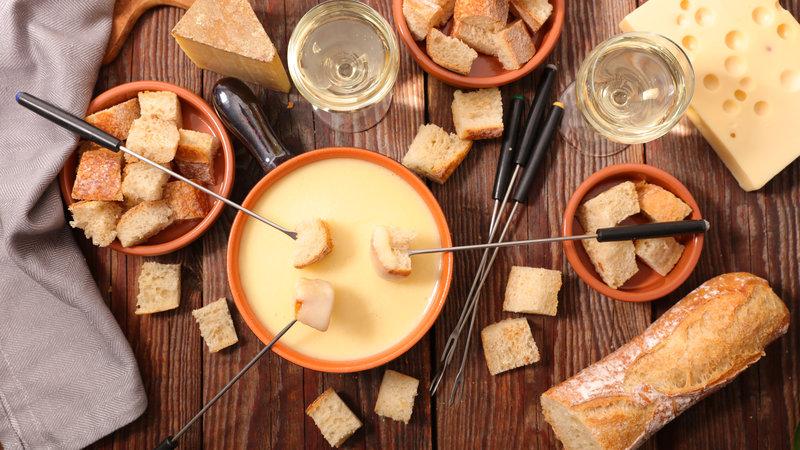The fundamentals of Swiss gastronomy: Raclette or Fondue?

'That is the question!'
This is not a joke. It’s one of the most significant topics of discussion in all the Swiss cantons. We’ll share a little secret: It all comes down to the cheese.
Raclette, the party starter
Let's start with raclette. This dish is a cherished winter tradition, shared in the joyful company of family and friends.
Long story short, raclette has a bit of a contested history with France, but to keep the mood light, we’ll steer clear of controversy. The general consensus is that raclette was invented by Swiss shepherds from the canton of Valais in the 19th-century. At the time, it was called Bratchäs or roasted cheese because it was heated over an open fire. Despite the type of cheese used, whether in Switzerland or France, raclette is a festive communal affair. The traditional raclette recipe, the one originating from the canton of Valais, calls for a special cheese, made of non-pasteurized cow milk, uncooked and pressed. Nationwide, raclette is largely prepared with Morbier or Saint-Nectaire cheese and pepper. It’s a matter of taste, but it’s impossible to go wrong when cheese is involved.
The charm of the raclette lies in its ritualistic generosity. Warm cheese is racler or scraped over tender boiled potatoes, accompanied by charcuterie, such as delicious slices of dried meat from the cantons of Grisons or Valais (among others), pickled onions, and a glass of Aigle des Murailles, all to be savored in moderation - or as you wish. and Alpine meat, pickled onions, and a glass of Aigle des Murailles, all to be savored in moderation - or as you wish.
Get your forks ready, if ...
- Raclette is your favorite way to get a party started
- You believe cheese is a dish best served hot, and with pickled sides
- Winter days are for skiing as winter nights are for raclette-ing
Fondue, a creamy delight
Every self-respecting Swiss home - and, of course, chalet - has a cuckoo clock and a caquelon, better known to English speakers as a fondue pot. By now it's as good as fact, the Swiss are experts in the field of melted cheese. One might say the proof is in the pudding, but in this case, the proof is in the fondue, which is celebrated as their national dish.
But it’s not as simple as heating a block of cheese, the recipe is a work of culinary art, with certain distinctions according to the region (aside from the essential garlic, if only for the delicious aroma it brings). However, the key to achieving the perfect Swiss fondue is the cheese itself, and its maturation of course.
The most common recipe is Fondue Moitié-Moitié or Half-and-Half: 50% Gruyère, 50% Vacherin Fribourgeois. While Fondue Fribourgeoise is 100% Vacherin, Fondue Neuchâteloise is 50% Gruyère, 50% Emmental (Swiss AOP). You see, subtle. However, in central Switzerland, the proportions are split into thirds: â…“ Emmental, â…“ Swiss Gruyère, â…“ Sbrinz (an ancestor of Parmesan). Finally, the Valais fondue is â…“ Alpine raclette cheese from the Valais, â…“ Swiss Gruyère, and â…“ Vacherin. You could never get bored with Swiss fondue (not that we thought you could) because there’s a recipe for every day of the week.
Purists prefer their fondue to be on the plain side but often give in to the fragrant flavors of ceps and morels. The savoir-faire of the art of fondue lies in getting right the perfect measure of white wine, and never forgetting a dash of kirsch. And watch closely, it would be sacrilegious to burn the fondue. The aftermath of cooking fondue can cause some tension: A fight for la religieuse, which literally translates to “the nun†but actually refers to the crispy burnt cheese on the pot’s edges, and the leftovers to be enjoyed later, perhaps topped with an egg prepared to your liking.
For you, fondue is la crème de la crème, if …
- You like to mix it up every once in a while
- No special occasion needed, you prefer an everyday pleasure
- Fondue is not only your favorite form of art, it’s your passion


